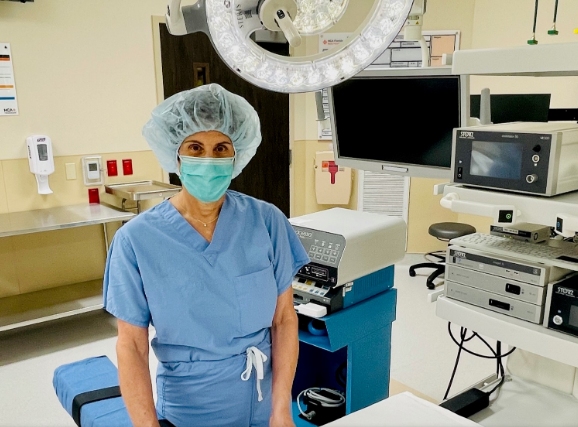ADVANCED SURGICAL SERVICES
IN-HOSPITAL PROCEDURES
Our fellowship-trained surgeons are comfortable with minimally-invasive surgeries, utilizing the newest technologies, to treat complicated and serious gynecological conditions. We have a private operating suite in our office where we can perform many procedures, and we enjoy privileges at Blake Hospital. Just minutes from our office, Blake prioritizes laparoscopic and robotic surgeries, and furnishes state-of-the-art operating theaters.
Hysterectomy
Our surgeons perform hysterectomies using advanced laparoscopic and robotic techniques. A hysterectomy is a surgical procedure to remove the uterus. Hysterectomies are done when medically necessary amd may also involve removal of the cervix, ovaries, and fallopian tubes. Partial hysterectomies allow for hormone regulation by leaving the ovaries in place, while total hysterectomies do not. Dr. Desai completed a fellowship in Minimally Invasive Gynecological Surgery at the University of North Carolina, Chapel Hill where she further enhanced her skills in Laparoscopic and Robotic Surgery. If you're struggling with abnormal bleeding or pain, please talk with your provider at your appointment about what can be done!
Go home the same day!
-
Go home the same day! -
Laparoscopy
Laparoscopy is an operation performed in the abdomen or pelvis using small incisions with the aid of a camera. This minimally invasive procedure is used to aid in the diagnosis and treatment of disorders such as endometriosis, fibroids, cysts, ectopic pregnancy, sterilization, etc. Laparoscopic surgery may also be performed to remove tubes and ovaries for medically necessary problems or permanent sterilization.
Myomectomy / Acessa
A myomectomy is a surgical procedure to remove uterine fibroids. These common noncancerous growths appear in the uterus. Uterine fibroids usually develop during childbearing years. Although most women are not bothered by a fibroid, some women may experience pain or abnormal bleeding. With a myomectomy, the fibroid is removed and the uterus remains intact. The Acessa procedure uses laparoscopy radiofrequency ablation (energy as heat) to cause coagulative necrosis of the fibroid tissue. The treated tissue softens and shrinks over time, allowing fibroid symptoms to resolve without difficult and time consuming surgery. Our surgeons are trained and experienced in all methods of fibroid treatments!
Save your uterus, treat the fibroid! Reduce the size and bleeding.
-
Save your uterus, treat the fibroid! Reduce the size and bleeding. -
A & P Repair (Colporrhaphy)
Anterior colporrhaphy (aka cystocele repair) tightens the vaginal wall overlying your bladder. Posterior colporrhaphy (aka rectocele repair) tightens the vaginal wall overlying the rectum. If you have a cystocele and/or rectocele, you may be a candidate for this outpatient procedure.
Dr. Pandiscio & Dr. Biggs both perform A&P Repairs.
Surgical Treatment for Urinary Incontinence
A sling procedure is a minimally invasive surgery designed to treat urinary incontinence. It involves placing a mesh sling under the urethra to provide support and prevent involuntary leakage of urine. This effective treatment helps restore confidence and improve quality of life for those struggling with urinary control issues.
Dr. Biggs performs sling procedures.
Labiaplasty
A labiaplasty is surgery to reduce the size of the labia minora, which are the flaps of skin at both sides of the vaginal opening. Labiaplasty has both functional and cosmetic benefits. Most women undergo surgery to reduce the excess labia which twists and turn and causes pain and irritation. If you're interested in this procedure, ask about a consult with Dr. Pandiscio!
IN-OFFICE PROCEDURES
Hysteroscopy
Hysteroscopy: Hysteroscopy is a procedure that allows your doctor to look directly inside of your uterus. It uses a hysteroscope, a long tube with a light and a camera on the end.
Polypectomy/Fibroids: Polyps are tissue growths that can occur all over the body. Sometimes polyps or firboids grow in the lining of the uterus or on the cervix and need to be removed.
All three of our physicians perform these procedures.
Ablation: (NovaSure) Looking for a cutting-edge way to treat heavy periods? This is an in-office procedure that treats heavy menstrual periods in just minutes by destroying the lining of your uterus - you can be free from your monthly bleeding!
Dilation & Curretage: A physician removes tissue from the lining of your uterus. This tissue is sent off for biopsy to help diagnose causes of certain gynecological problems such as abnormal vaginal bleeding.
The MyoSure® tissue removal procedure is a hysteroscopic treatment designed to remove uterine tissue, including fibroids and polyps. The simplicity of this technique allows women to alleviate heavy periods, frequent urination, and other abnormal uterine symptoms without having to undergo major surgery. MyoSure leaves the uterus intact!
Cystoscopy
A cystoscopy is a procedure to look inside the bladder using a thin camera called a cystoscope. A cystoscope is inserted into the urethra (the tube that carries pee out of the body) and passed into the bladder to allow the doctor to see inside. A cystoscopy is performed to check for the cause of problems such as blood in your urine, frequent urinary tract infections (UTIs), problems peeing, etc.
Dr. Desai & Dr. Biggs perform this procedure right here in the surgical suite in our office! It's a quick procedure that does not require anesthesia.
LONG-acting reversible contraception
IUD: Interested in a long-acting and reversible option for pregnancy protection? An Intrauterine Device (IUD) may be the way to go. An IUD is a small T-shaped device that sits in your uterus and works in a variety of ways to protect you from pregnancy, and helps women who struggle with heavy and excessively painful periods. This can be inserted by one of our providers during a quick office visit, and removed just as easily.
We don't want you to suffer through an IUD insertion. They're uncomfortable enough as it is, we want to make it easier on you! We offer Ibuprofen or Intramuscular Toradol Injections, Cytotec to dilate and soften the cervix, use of a heating pad among others. We also offer an option for oral anti-anxiety medication and in-office sedation if necessary. Your comfort and pain free procedures are important to us!
Nexplanon: This hormone-releasing implant is the most effective birth control method available today. Placed in our office, the matchstick sized rod is inserted just under the skin in the upper inner arm for 3 years of worry free, long acting pregnancy protection.
Endometrial biopsy
A biopsy of tissue from the lining of the uterus is used to evaluate abnormal bleeding. It can be performed by any of the providers in our office, and does not require sedation.
VUlvar Care
Vulvoscopy: A vulvoscopy looks at the vulva under a microscope to identify disease that may not be able to be seen by the naked eye.
A vulvar biopsy is performed using local anesthesia to send the sample to the lab for testing. All of the providers in our office can perform this procedure!
Cervical CAre
Colposcopy: A colposcopy, or “colpo”, is an examination of your cervix using a special microscope to identify any areas of unhealthy cells. One or more biopsies are usually taken during this procedure to confirm the level of cellular changes present.
Cryosurgery: A procedure that uses nitrogen gas that freezes and destroys precancerous cells on the cervix. After these unhealthy cells are destroyed, the body can replace them with new, healthy cells.
LEEP: A small electrical wire loop is used to remove the abnormal cells from your cervix during this in-office procedure, after your cervix has been numbed with a cervical block.
Cone Biopsy: Cone biopsy involves using a surgical knife (scalpel) to cut abnormal tissue from your cervix. The tissue is sent to a lab where a pathologist studies it for precancerous or cancerous cells. Cryosurgery and LEEP are done in office in our surgical suite under light sedation, Cone Biopsies, however, are done at the hospital.
Pudendal Nerve Block
A Pudendal Nerve block is a procedure to treat symptoms of genital, pelvic, tailbone, and/or rectal pain by blocking the nerve impulses. The pudendal nerve is located deep in the pelvis and follows a path that comes from the sacral area and later separates into three branches, one going to the rectal area, one to the perineum, and one to the clitoris. The leading cause of this problem is myofascial dysfunction. Indeed, hypertonic muscles (too tight muscles), myofascial trigger points, joint dysfunction, and connective tissue restrictions can cause pudendal nerve irritation and the symptoms of pudendal neuralgia: sharp, shooting, or burning pain in the territory of the nerve. Dr. Desai often uses Pudendal Nerve Blocks in conjunction with Pelvic Floor Physical Therapy.
Mona Lisa TOuch
This is a novel non-hormonal approach to managing distressing vaginal symptoms including painful intercourse, vaginal dryness, Lichen Sclerosus, and urinary incontinence. Mona Lisa Touch is a fractional CO2 laser for gynecologic use that delivers energy to tissue. It is a series of treatments with a state-of-the-art laser that is performed in our office to improve vascularization and connective tissue within the vagina and on the vulva. This laser is used for atrophy, Lichen Sclerosus, patches of white. It's an easy procedure with no downtime.
Dr. Desai, Dr. Pandiscio, and Sammie Billman currently perform Mona Lisa Touch.

